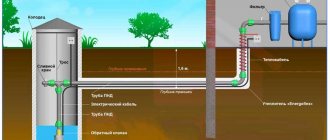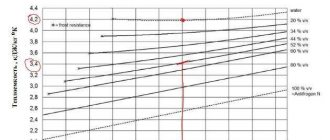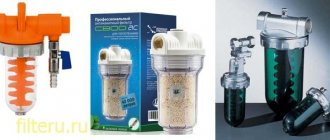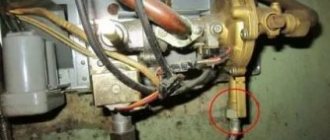When and why is water drained?
For any intervention in the heating circuit, which is associated with the replacement of its elements, it is necessary to drain the water from the heating system, because it is impossible to carry out work on a system filled with water.
The main list of works requiring the removal of coolant from pipelines and batteries is as follows:
- replacement of radiators;
- eliminating leaks;
- preventive maintenance, removal of contaminants;
- replacement of coolant.
Draining coolant from an autonomous system
The process of removing water from pipelines and batteries of an autonomous heating system of a private house does not require any permission or approval. What needs to be done next and how to drain the water from the heating system is described below.
The following simple rules must be followed:
- turn off the boiler (of any type) and allow the coolant to cool;
- close the cold water make-up valve;
- open the air valves (for a closed system).
In a properly installed system, there is a drain valve located at the lowest point of the system. It is usually located on the return pipe near the boiler. A hose is connected to the drain tap, through which water is removed from the circuit. After the water has been completely removed, you can begin to realize the purpose for which the coolant was drained. If heated floors are installed, then water can be removed from the pipelines only by connecting a compressor to the inlet pipe to displace it with air pressure.
However, situations often arise that do not require complete drainage of the water. For example, replacing or repairing a separate battery. The answer to the question - how to drain water from a heating battery - is simple if the design of the system has been carefully thought out and installed. To make this operation easy and quick, even when designing the circuit, it is necessary to provide for the possibility of cutting off the radiator from the system, without disrupting its operation.
Let's assume that all the recommendations have been followed, the battery is disconnected from the system by shut-off valves on it, but how to drain the water from the heating battery if there is a very significant amount of water in it, especially if the battery is cast iron. Therefore, it is necessary to install a container of sufficient volume to collect leaking water when disconnecting the radiator from the circuit. If the homeowner does not have the necessary skills, or does not understand how to drain the water from the heating system, then it is better to invite a heating specialist.
Draining water from heating systems of multi-storey buildings
If the apartment is located in a multi-story building, then such an operation is complicated by several factors. When performing repair or modernization work on the heating system, it is necessary to drain the water from the riser. To do this, you need approval from the company that services the heating of the house. Every resident should know where to go regarding heating if problems arise. The water drainage service is paid, and during the heating season it is extremely expensive and hourly. Therefore, it is better to plan the work for the summer period, when the coolant is drained, but permission to carry out the work and shut off the riser must be obtained.
Boilers
Residential premises are heated by a boiler with one or two circuits. In the second case, the owners also provide themselves with hot water.
Many heating devices also have internal cavities where the coolant reaches a given temperature. And after draining the liquid from the unit, its interior becomes free of water, and convenient conditions are created for working with all components and contacts.
The nuances of emptying boilers in the house were reflected above. But there are some more subtleties:
How to drain water from a double-circuit gas boiler correctly? This means emptying the heat exchanger. To do this, turn off the boiler and open the hot water tap until it cools down. After this, the flow of cold water is blocked. If necessary, all its contents are removed from the heat exchanger. Then the hot water supply fitting is unscrewed.
How to drain water from a modern wall-mounted gas boiler? Such devices have a drain fitting and an air vent. These elements work automatically. And to free such a boiler from liquid, simply open the drain valve after the preparatory stages.
Replacing a radiator in an apartment building
If you only need to change the radiator for repairs, then every apartment owner must know how to properly shut off the radiator. If the system in the house was installed in good faith, then this possibility certainly exists.
Knowing how to shut off a heating battery is also necessary to prevent various emergencies, such as a severe leak due to the destruction of the radiator. Every owner needs to know the phone number of the organization where to contact about heating immediately in the event of an emergency.
If a single-pipe heating scheme is used, then a bypass must be installed. Every apartment owner should have a clear and precise understanding of how to shut off the heating radiator in this case.
With such a circuit diagram, the following actions are carried out:
- the bypass valve opens completely;
- close the shut-off valves on the battery on both sides.
Having completed these operations, you can begin to remove the radiator from the system.
After replacing the battery, sealing the connections and tightening the locknuts, gradually open the valves at the battery inlet and outlet.
At the same time, the Mayevsky tap opens and the bypass closes. Slowly filling the battery prevents water hammer, and the air from the battery is released through the Mayevsky tap until water appears. This will mean that the battery is filled with liquid, the air has been removed, and the shut-off valves on the battery can be opened completely.
Some heating problems that do not require draining
Most often, heating problems are associated with the fact that water does not circulate in the heating system, for various reasons.
There are many reasons and the most common are:
- presence of air in the heating circuit;
- system contamination;
- pipeline diameter is too small;
- the power of the circulation pump is insufficient;
- in complex systems there are no check valves;
- violations during installation of the system.
Many disturbances in heating systems are interconnected, for example, water babbling in heating pipes. This phenomenon can cause discomfort and complaints - the heating radiators in the house make noise. Each person perceives the sounds that a heating system may produce differently. Some people think that the heating is humming, others perceive these sounds as humming. Unpleasant sounds include knocking on radiators during operation of the system.
Noises in heating circuits are phenomena of the same order and there are quite a lot of reasons that cause them:
- the presence of air in the system, it must be removed;
- constant air leaks due to poor sealing of connections;
- coolant speed is too high;
- malfunction of the expansion tank (closed system);
- estrus in the system;
- incorrect connection of the thermal valve;
- errors in the design or during installation of the circuit.
Draining the heating system: design features and operating rules
When faced with repair work, going on a long trip or becoming a victim of an emergency, many people wonder whether it is necessary to drain the water from the heating system? In most cases, the answer is positive, although there are also situations where it is possible to fix a problem or make repairs with radiators filled with liquid.
Although the draining procedure is not particularly complicated, following the operating rules is an important nuance. If you violate the procedure, you can flood the floors in your own home with water. And if the drainage is carried out in a multi-story building, then neighbors may also suffer from incorrect actions.
Why drain heat down the drain?
Up to half the volume of make-up water sent by the thermal power plant to the heat supply network in Novokuznetsk is simply thrown away.
On the eve of the New Year holidays, shocking news arrived from house No. 4 on Festivalnaya Street: the apartments are “dubak”, the entrances are freezing. The numb residents, tired of the cold in their apartments, rebelled and, gathering together, sent an angry video message to the mayor of Novokuznetsk and the governor of Kuzbass. After a response in the local media, the situation returned to normal.
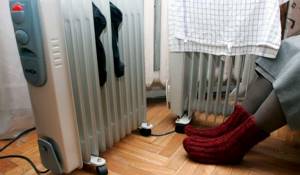
As it became known, the anger of citizens expressed towards the management company was justified - the reason was not an accident on the heating main, not a decrease in the parameters of the coolant in the system, but incorrect adjustment of thermal units, the “human factor”. The intervention of specialists allowed the cool radiators in some apartments to become hot.
Before the publication of the article, we contacted one of the initiators of the “revolt” at Festivalnaya, 4 and received assurance: at this time it is warm in the apartments.
We asked the chief engineer of EnergoTransit LLC, Alexey SALOMATOV, to comment on the situation both in this house and in the housing stock in general.
- Yes, we were forced to intervene then, together with employees of the Central District Administration we arrived at the address. It was discovered that the management company, unfortunately, in violation of the established rules, uses direct network water, without admixture, for in-house heating networks. This is the main reason for the problems of this house (and many others), the lack of adjustment.
— But mixing is the use of water that has already passed through the internal network, the temperature of which is slightly lower than that coming from the thermal power plant, right? This means that after mixing the batteries will not be hotter, but colder, isn’t it?
— Apparently, the would-be specialists of management companies think like this!.. But in reality this is not so. Not only the temperature of the coolant is important, but the circulation and speed of its passage through the intra-house networks! And the most important characteristic is heat removal from heating devices. That is, how much heat the coolant transfers to the consumer as it passes through the batteries. When the inside of the appliances is “overgrown” with rust and deposits, the heat transfer decreases sharply, the water goes back to the thermal power plant hot, this is very bad for both the residents and the thermal power plant too... If there is no mixture, the circulation deteriorates: those entrances that are located next to the inputs warm up , but the end risers are “standing”, which means that people’s apartments are cold. Management company specialists should understand this, but they often do not do enough.
- This means that the in-house systems need to be flushed. After all, these are routine works that are paid for by residents, right?
- Absolutely necessary! And wash and replace old heating risers that have served their purpose. Not long ago, in a house on Stroiteley, 100, we saw a pipe after replacement. The internal diameter of 18 millimeters has been reduced threefold to 6 millimeters. The cross-sectional area has correspondingly become almost ten times smaller!!! What kind of coolant circulation through such a pipe can we talk about?.. Routine work on flushing and replacing in-house wiring and appliances is a very important part of the activities of management companies and, unfortunately, very neglected.
Another problem that we encounter in our activities is the unauthorized draining of network water from heat consumption systems into the sewerage system.
— That is, not in the “return”?
- Yes.
- Why is this happening? And where exactly?
— For example, at Transportnaya, 5. There is deregulation of the whole block. The problem concerns houses numbered 3, 5, 9, 11, 13, 23, 27 on Transportnaya Street. Previously there were pumps that provided forced circulation. Now the equipment is out of order, the wires have been cut. This has a particularly detrimental effect on the 5th house, where, due to a problem, the heating system was “set to reset.”
— Do they pour the coolant down the drain instead of returning it back to the Central Thermal Power Plant?
- Exactly. This, I think, is barbaric and wasteful! The prepared and heated water is thrown away. There it is necessary to start up pumping equipment, adjust hydraulic modes and ensure normal heat supply. But management companies don’t want to do this. Thus, every hour 60-90 cubic meters go into the sewer!
— How much water from the Central Thermal Power Plant goes into the sewer system, since the house on Transportnaya, 5, apparently, is not the only one?
— On average, the make-up volume should be about 300 tons per hour (this is the volume of coolant that consumers use for hot water supply services - author’s note). In fact, it reaches 600 tons per hour, that is, twice as much!
As reported in a press release sent by EnergoTransit LLC, the presence of heat and comfort in an apartment in an apartment building directly depends on the maintenance of the building’s utility networks. Management companies need to flush the risers of heating systems in the prescribed manner, using special chemicals, timely replacement of risers and heating devices, as well as adjusting the heating system to improve the temperature and hydraulic conditions of the intra-house systems of residential buildings under maintenance.
“However, management companies often, in order to solve the problem and resolve issues with residents, drain hot water from the heating system into the sewerage system (set the house to be discharged), which leads to significant losses of generated heat and disrupts the hydraulic mode and thermal mode of operation of the heating network, which entails a deterioration in comfortable temperature conditions in neighboring residential buildings.
At the same time, the heat supply organization is forced to compensate for the withdrawal of hot water by adding make-up water (which requires special preparation) supplied to the heating network to replenish coolant losses, as well as water withdrawal for thermal consumption, which entails additional costs.
Moreover, these actions of management companies cause harm not only to the city’s heat supply system, but also direct damage to both organizations providing heat supply and citizens, which may lead to the application of civil and administrative measures to the guilty management companies, as well as liability up to and including criminal liability. persecution.
EnergoTransit LLC regularly conducts inspections to detect and eliminate unauthorized discharge of network water from heat consumption systems in apartment buildings, records this fact, makes calculations and recovers the cost of the lost coolant from the management organization.”
Why do you need to drain water from heating systems?

Draining the heating system is necessary in the following cases:
- when it is necessary to eliminate leaks in pipes;
- if old radiators are replaced with more modern models;
- when preventive measures are taken to clean the system of accumulated contaminants;
- if you need to replace the coolant.
It is impossible to carry out this work with filled cavities of batteries and pipes. Water is drained in the event of an emergency or at a time when the owners of the homes intend to leave the premises for a long time.
Design features of the heating system drain
The heating system of an apartment building and a private building has significant differences. Heating in cottages occurs through an autonomous system, which includes a boiler, pipelines, valves and radiators themselves, and sometimes an installed underfloor heating system.
In multi-storey buildings, the main structural elements are the supply and return risers, the internal piping system, shut-off valves, drain valves and the radiators themselves. In this regard, draining water from the heating system will be slightly different for both systems, although the operating principle is the same.
How to properly drain a heating system?
Having understood the main elements of the heating structure, you can begin to empty it. How to properly drain the heating system in private and apartment buildings?
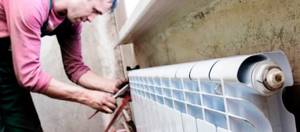
Drain in a private house
For the draining procedure, the cottage owner will have to prepare a hose in advance, through which the liquid released from the system will flow. One end of the hose is connected to the boiler tap, the other is sent to the most convenient place for the home owner, where the structure can be emptied without damage (on the land of a personal plot, sewer).
Sequence of actions for draining water:
- The boiler turns off and its operation stops.
- A hose is attached to the boiler return valve (usually the outlet pipe is located on the right side under the boiler), so emptying occurs faster. If the crane is not located under the structure, refer to the free-standing system diagram and find out its location. The return part of the hose is directed into a sewer drain, front garden or a regular bucket.
- Open the valve and wait until the liquid stops flowing out (the pressure in the system decreases during this period), then close the valve back.
- After draining, care must be taken to ensure air access into the cavity of the structure. To do this, it is necessary to open the so-called Mayevsky valve, which is usually located at the highest point of the autonomous system. For example, on a heated towel rail or one of the radiators (if the cottage is two-story, then Mayevsky’s tap will be on the radiator of the 2nd floor).
- The air will begin to push out the remaining water from the batteries and the boiler, so draining must be done again.
- Now that there is practically no liquid left in the system, its insignificant remains are “blown out” by opening all the Mayevsky taps in the structure, and the water is drained again.
- Now the end of the hose, attached to the return pipe, is removed from it and attached to the supply valve.
- The final drainage of liquid from the heating system is carried out. To achieve maximum emptying, it is necessary to install the hose as low as possible in relation to the outlet taps.
However, if the owner of a private house has a heated floor system installed, then the above-described scheme will not help him. To remove liquid from it, you will need to use a special compressor.
Drain in an apartment building
Emptying the heating system in a multi-story building is more difficult in that it is necessary to obtain permission from the local management company to drain the riser. This service is paid, and the date will be set not by the owner of the apartment, but by housing and communal services employees, which may cause some inconvenience.
It is better to plan heating system repair work for the end of spring - summer - beginning of autumn, since during the heating period it is possible to drain the liquid only for a few hours and at a high cost.
However, it is possible to replace the battery or carry out minor repairs without emptying the entire heating structure. Most radiators are equipped with valves that can be used to block the flow of coolant to a local area.
- The tap is closed to shut off the water supply to the radiators.
- Using an adjustable wrench, remove the plug or, if present, open the outlet valve. The liquid is drained into a basin or bucket.
- If there are no outlet holes, you will have to disconnect the battery completely and get rid of the coolant through the top.
If more serious repairs are required than just replacing the radiator, then you need to drain the riser. This procedure is performed by management company employees as follows:
- The valve in the attic or ceiling of the upper floor is closed.
- The valve in the basement or basement closes.
- The plug is removed or the drain valves are opened, and the coolant is discharged from the system.
As you can see, the procedure for ridding the system of coolant has significant differences for different types of houses.
Preservation of the summer cottage water supply system
Frosts can destroy pumping equipment, pipes, and household appliances if liquid is left in them for the winter, when the system is not insulated and the country house is not heated. Therefore, water is removed from wherever it might freeze. This is convenient to do if, during the construction of the water supply system, a liquid drainage system has been thought out.
To do this, install shut-off and control valves:
- On the water supply pipe to the house in front of the check valve there is a tee with a tap.
- On the internal wiring at the lowest points there are valves for draining.
- If the pipes are under flooring, install compressor adapters to vent the system.
- On the pipe leading to the boiler, in front of the check valve, there is a tee with a tap. The same fittings are mounted on the outlet hose.
- Do not use single-lever faucets, which burst in the cold if there is even a little liquid left in them. Install ceramic taps with rubber gaskets.
Such preliminary work, taken into account when designing the water supply system, makes it easier to drain water for the winter.
Draining water from your home plumbing
To drain water from the pipeline leading into the house, open the tap, which is located in front of the check valve. You can hear the bubbling of liquid and noise from escaping air bubbles. If there is no special valve, disconnect the pipes at the very bottom and drain the water.
They move on to the water heater, which is pre-cooled. If there are no drain taps, unscrew the safety valve and connect a piece of hose. The nut on the outlet pipe is released - air is sucked from the boiler, and water is drained through the connected hose. If the liquid is hot, do not pour it into the septic tank - the boiling water will kill the bacteria. A long hose is taken outside and discharged.
There is some water left in the washing machine. It is located in the hose that goes from the tank to the pump. They squeeze it and, using it like a pear, remove the residue, which goes into the drain hose. Turn the car over and place it on the roof. This will get rid of any liquid that remains in the unit. In this position it is left to spend the winter.
Drain the water from the shower. First, unscrew the watering can. Open the taps one by one. They use a compressor connected to a hose, an air pump, or blow air out of the lungs. The position of the valves is changed to drain the liquid from the supply hoses for cold and hot water.
They proceed to the toilet. Drain the water from the flush tank. Pump out the water seal completely using a pump, syringe, or sprayer. If odors leak from the septic tank, fill in with anti-freezing automotive fluid, a saturated saline solution. In the spring it is removed without washing it into a septic tank - it is detrimental to the microflora.
Plumbing diagram for a dacha.
Unwind all the siphons and remove any remaining liquid in the glasses. Remove the filters and pour out the water. Do not forget about the drain if it is used in the shower stall for water drainage.
What remained was the pumping station, which had previously been disconnected from the network. Unscrew the cap and pour the water into the prepared container. It is advisable to blow with compressed air so that any remaining liquid leaves the hydraulic tank. If water remains in it, freezing damages the rubber membrane.
If the internal distribution pipes are located strictly horizontally, the water will not completely leave them by gravity. Blowing with a compressor is required.
Conservation of street water supply
At the dacha, they often use summer water supply for watering, outdoor showers, and car washing. Pipes laid on the surface are the first to suffer from frost. If there is a drain valve in front of the check valve, open it. Then the pump can be left in the source for the winter - it will not freeze. When there is no drain valve, pull out the pump and disconnect it from the water supply hose. When water is drained from the system, all water taps are opened.
Empty the storage tank and the container for the summer shower. Remove the watering can from it, open the tap, remove the remaining liquid.
For drainage to be effective, the pipes must be placed on a slope. Then the water will not linger in some place. Even a small amount of it, when frozen, can break the seal. If there is no required slope, connect the compressor and blow out the pipes with compressed air. Such an operation will not interfere, even if a drain valve is installed on the main line at the end point.
Conservation of street water supply.
The summer water supply hoses are wound up, freed from water, and put away for winter storage. Pipes dug shallow into the ground are blown out. Fittings exposed to the surface are removed, dried, and stored indoors until spring. If the water valves are not removed, they are left open. Ball valves especially suffer from frost. For the winter they are left half-open outside.
Plastic pipelines are not as susceptible to freezing as steel ones, but their threaded fittings suffer. Therefore, it is better to use welded joints. Polypropylene pipes are not destroyed by freezing. They are used if it is not possible to blow out the water supply with a compressor for preservation.
Draining water from the heating system of an apartment building
Is water drained from batteries in multi-storey buildings in summer?
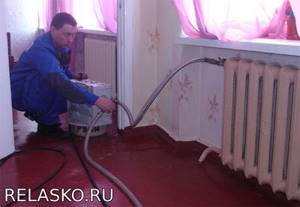
Is it necessary to drain water from heating in summer before pressure testing?
In this article we want to look at the question of whether it is necessary to drain water from the heating system before pressure testing?
Pressure testing of the heating system is an annual event, which is carried out in the spring and summer. The required amount of preparatory work is determined based on the order issued by MOEK at the end of the heating period.
The order is drawn up by a MOEK inspector, who writes down all the activities that need to be carried out with the system during the preparatory work and based on the comments of the previous year.
As a rule, the order contains several items, such as: checking pressure gauges, checking thermometers, restoring insulation on pipelines, painting the elevator unit, conducting hydraulic tests or pressure testing and flushing the heating system.
Flushing the heating system may not be included in all regulations. Therefore, if the instructions contain a clause about flushing, then this procedure must be performed before crimping.
The system flushing procedure involves repeated filling and draining of water (coolant) from the system. Washing is performed several times until the water becomes clarified.
Emergency drain of water from the heating system
Mazaika wrote: Non-contacts were a common problem in computers. On board connectors. They searched using the tapping method.
This is true. Search for “floating” defects. Heating, cooling, and rocking are also used. It just so happened that my dead computer diploma...
Mazaika wrote: So, an experienced repairman knew where, with what force and at what angle to hit with a hammer. For the computer to work.
But this is not entirely on topic. Just an experience. Far from professionalism.
When I was at a training camp in the air defense division, there was an old kung car - a control room with an ancient computer, all the way to the ft... The car wouldn’t start - VASYA was called from the unit. Vasya powerfully kicked one block with his kirzach - the light bulbs blinked merrily...
Pro?! No, he just has a stronger kick than others and a larger foot size
Mazaika wrote: What is the difference between a professional and a dialetian? ... ... and the dialetian laughs at how a professional “knocks with a hammer.” From his point of view, it is worth nothing and is not valued in any way.
The original of this accordion is here (but perhaps there are deeper historical roots):
Academician P. KAPITSA wrote: ABOUT THE ROLE OF SCIENCE IN THE PATRIOTIC WAR
It happened at one factory, where some kind of large machine was built, it seems, a special type of blower. The plant could not put it into use. Engineers spent a long time working on it, the workshops stood still, but the blower did not work. Finally, the director of the plant decided that it was necessary to resort to outside forces, and invited a prominent specialist, whose name, unfortunately, I did not remember, for a consultation. The director did not decide to take this step right away, since he was stingy and did not want to spend extra money on inviting large professors, who in England have to pay large sums for consulting.
The professor arrived, looked at the car, asked for a hammer or sledgehammer and hit the body of the car several times. Some parts inside must have moved, snapped into place, and the machine started working. The workshops began to operate, the plant came to life. The professor returned home and, according to English custom, sent the director of the plant a bill for, it seems, 100 pounds sterling (at that time it was approximately 1000 rubles in gold) - a considerable amount. The director was upset and indignant. “What is this - a man came, hit him with a hammer two or three times and left, and I have to pay 100 pounds for this. We need to knock this professor down,” he decided and sent the scientist a letter in which he delicately asked for a more accurate assessment of his work. To this he received the following answer: “For coming to the factory and hitting with a hammer,” the professor wrote, “I am entitled to 1 pound sterling, and for the fact that I knew where to hit with the hammer, I should pay the remaining 99 pounds.”
Why is water drained from the heating system?
Water from the heating system must be drained in order to carry out repair work and improve the quality of coolant supply. Basic work that requires draining water from the heating system:
- Replacement of plumbing fixtures.
- Repair work, elimination of leaks.
- Preventive flushing and de-airing of the system.
- Replacing the coolant.

Draining water from the system in a private house is mandatory when the owners are absent for a long time. During this period, no one monitors the boiler, and the coolant does not heat up. The liquid in the pipes cools, freezes, expands and can rupture them. If the house has heated floors that are heated with water, then if they are damaged, repaired, or the owners leave, the water must be drained.
System design features
The design of the heating system in an apartment building is of two types: two-pipe and single-pipe. The single-pipe system has the main disadvantage of cooling the water on its way to the upper floors. Heat is directed from the bottom up under pressure, bypasses all thermal circuits and flows back through the same pipe.
In a two-pipe heating system, the coolant returns back through the second pipe, and the temperature is maintained high as it enters the system throughout its entire route.
Heating systems are also divided into open and closed. In an open system, water comes directly from the heating plant and is distributed through heating and hot water pipes. Most apartment buildings are built according to this type.
In a closed system, water flows only for heating purposes. From the heating plant, water is distributed to heating points, where it is brought to the required temperature before being supplied to residents. A closed autonomous system is also installed in private homes. Installation of an autonomous closed heating system is carried out with the expectation that any part of it can be turned off and the water drained without damaging the remaining part. To do this, ball shut-off valves are installed at the inlet and outlet of radiators. A spare pipe - bypass - is installed. Taps allow you to shut off the coolant supply.
In order for the heating system inside the apartment to be serviced without problems, it must be installed in a certain way. The batteries are placed on a slope so that the water drains quickly.
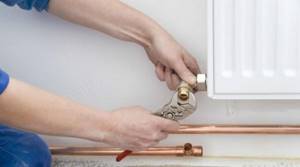
To drain water from the heating system, the battery must be mounted in a certain way
The batteries must be equipped with shut-off valves, a Mayevsky tap and a tap for draining water. Old cast iron batteries in most cases do not have any fittings. They have a plug installed in the lower part, but over years of use it becomes tightly fused with the radiator and can be painted over many times.
In the heating riser and radiators of an apartment building, water is present at any time of the year, only its temperature is different. In winter, hot water moves through the system; in summer, it is cold. When carrying out serious work, draining the coolant from the pipes is mandatory in any season.
Up to half the volume of make-up water sent by the thermal power plant to the heat supply network in Novokuznetsk... is simply thrown away.
On the eve of the New Year holidays, shocking news arrived from house No. 4 on Festivalnaya Street: the apartments are “dubak”, the entrances are freezing. The numb residents, tired of the cold in their apartments, rebelled and, gathering together, sent an angry video message to the mayor of Novokuznetsk and the governor of Kuzbass.
After a response in the local media, the situation returned to normal.
As it became known, the anger of citizens expressed towards the management company was justified - the reason was not an accident on the heating main, not a decrease in the parameters of the coolant in the system, but incorrect adjustment of thermal units, the “human factor”. The intervention of specialists allowed the cool radiators in some apartments to become hot.
Before the publication of the article, we contacted one of the initiators of the “revolt” at Festivalnaya, 4 and received assurance: at this time it is warm in the apartments.
We asked the chief engineer of EnergoTransit LLC, Alexey SALOMATOV, to comment on the situation both in this house and in the housing stock in general.
- Yes, we were forced to intervene then, together with employees of the Central District Administration we arrived at the address. It was discovered that the management company, unfortunately, in violation of the established rules, uses direct network water, without admixture, for in-house heating networks. This is the main reason for the problems of this house (and many others), the lack of adjustment.
- But mixing is the use of water that has already passed through the internal network, the temperature of which is slightly lower than that coming from the thermal power plant, right? This means that after mixing the batteries will not be hotter, but colder, isn’t it?
— Apparently, the would-be specialists of management companies think like this!.. But in reality this is not so. Not only the temperature of the coolant is important, but the circulation and speed of its passage through the intra-house networks! And the most important characteristic is heat removal from heating devices. That is, how much heat the coolant transfers to the consumer as it passes through the batteries. When the inside of the appliances is “overgrown” with rust and deposits, the heat transfer decreases sharply, the water goes back to the thermal power plant hot, this is very bad for both the residents and the thermal power plant too... If there is no mixture, the circulation deteriorates: those entrances that are located next to the inputs warm up , but the end risers are “standing”, which means that people’s apartments are cold. Management company specialists should understand this, but they often do not do enough.
- This means that the in-house systems need to be flushed. After all, these are routine works that are paid for by residents, right?
- Absolutely necessary! And wash and replace old heating risers that have served their purpose. Not long ago, in a house on Stroiteley, 100, we saw a pipe after replacement. The internal diameter of 18 millimeters was reduced threefold - to 6 millimeters. The cross-sectional area has correspondingly become almost ten times smaller!!! What kind of coolant circulation through such a pipe can we talk about?.. Routine work on flushing and replacing in-house wiring and appliances is a very important part of the activities of management companies and, unfortunately, very neglected.
Another problem that we encounter in our activities is the unauthorized draining of network water from heat consumption systems into the sewerage system.
- Why is this happening? And where exactly?
— For example, at Transportnaya, 5. There is deregulation of the whole block. The problem concerns houses numbered 3, 5, 9, 11, 13, 23, 27 on Transportnaya Street. Previously there were pumps that provided forced circulation. Now the equipment is out of order, the wires have been cut. This has a particularly detrimental effect on the 5th house, where, due to a problem, the heating system was “set to reset.”
— Do they pour the coolant down the drain instead of returning it back to the Central Thermal Power Plant?
- Exactly. This, I think, is barbaric and wasteful! The prepared and heated water is thrown away. There it is necessary to start up pumping equipment, adjust hydraulic modes and ensure normal heat supply. But management companies don’t want to do this. Thus, every hour 60-90 cubic meters go into the sewer!
— How much water from the Central Thermal Power Plant goes into the sewer system, since the house on Transportnaya, 5, apparently, is not the only one?
— On average, the make-up volume should be about 300 tons per hour (this is the volume of coolant that consumers use for hot water supply services — author’s note). In fact, it reaches 600 tons per hour, that is, twice as much!
...As reported in the press release sent by EnergoTransit LLC, the presence of heat and comfort in an apartment in an apartment building directly depends on the maintenance of the building’s utility networks.
Management companies need to flush the risers of heating systems in the prescribed manner, using special chemicals, timely replacement of risers and heating devices, as well as adjusting the heating system to improve the temperature and hydraulic conditions of the intra-house systems of residential buildings under maintenance.
“However, management companies often, in order to solve the problem and resolve issues with residents, drain hot water from the heating system into the sewerage system (set the house to be discharged), which leads to significant losses of generated heat and disrupts the hydraulic mode and thermal mode of operation of the heating network, which entails a deterioration in comfortable temperature conditions in neighboring residential buildings.
At the same time, the heat supply organization is forced to compensate for the withdrawal of hot water by adding make-up water (which requires special preparation) supplied to the heating network to replenish coolant losses, as well as water withdrawal for thermal consumption, which entails additional costs.
Moreover, these actions of management companies cause harm not only to the city’s heat supply system, but also direct damage to both organizations providing heat supply and citizens, which may lead to the application of civil and administrative measures to the guilty management companies, as well as liability up to and including criminal liability. persecution.
"EnergoTransit" LLC regularly conducts inspections to detect and eliminate unauthorized discharge of network water from heat consumption systems in apartment buildings, records this fact, makes calculations and recovers the cost of the lost coolant from the management organization," the press release says.
Sergey Shtil.
For reference: Since July 4, 2018, EnergoTransit LLC has been a heat supply organization that charges for heating and hot water supply services to consumers. EnergoTransit purchases thermal energy from the heat source Central Thermal Power Plant and ensures supply to its consumers under heat supply contracts and to residents of apartment buildings.
The accrual is made to consumer citizens on almost 34 thousand personal accounts and on about 1.4 thousand heat supply contracts with legal entities.
EnergoTransit LLC works with 65 management organizations of Novokuznetsk and supplies thermal energy and hot water to 655 apartment buildings in the city of Novokuznetsk, of which 582 apartment buildings are with consumer citizens, and makes direct payments on personal accounts opened with EnergoTransit.
Within the scope of EnergoTransit LLC, about 160 apartment buildings have installed communal metering devices.
Source: “Kuznetsky worker”
Source: Novo-TV News
Tags: VIDEO, Heating season, Problem You can leave a comment.
Rules and stages for draining water from the heating system
How to properly drain water from the heating system in a house or apartment? It is necessary to take into account the design features of the heating system and follow the procedure.
Draining the heating system in a private house
The heating system of a private house is usually autonomous and draining does not require any permits or agreements with neighbors. It is recommended to drain the heating system in the following order:
- Disconnect the heating boiler from the network.
- The water in the pipes and radiators must cool completely.
- Turn off the cold water tap.
- Open the air valve.
- Open the valves on the radiator and boiler.
- Connect the hose to the drain valve, which is located on the return pipe near the boiler. The other end of the hose must be lowered into the toilet or a large container if the hose is short.
- Open the drain valve.
- Pump out the water until the pressure gauge shows zero.
- Open the Mayevsky tap and let air into the heating system. The air will push out any remaining water.
- Move the hose to the supply valve, open it and drain the liquid from the upper pipe.
How to drain water from batteries with a shut-off valve
A heating system is integrally present in every apartment. The owner of the house simply must have basic knowledge of network maintenance. If an emergency situation occurs, for example a pipe burst, knowledge in this area will help avoid an accident.
Step 1: Turn off the water supply. Before you start draining, you must stop the circulation of coolant in the system. Then wait until the pipes have cooled completely. If you are going to replace or restore radiators, let them cool down too. If an autonomous shut-off valve is not provided in your home, then the water can be drained only after the end of the heating season. In the event of an accident, special services staff shut off the entire heating riser.
Step 2. Turn off the boiler, if provided . If the boiler in the house runs on solid fuel, it is better to put out the fire and wait until the boiler has cooled completely. If the boiler is electric, turn off the nozzles completely and remove the plug from the socket. In the case of central heating, this point is not relevant.
Step 3. Turn off the water supply to the boiler . Before draining the heating system, stop the water supply to the heating unit, which will prevent liquid from entering it during operation. For this purpose, a separate shut-off valve must be installed.
Depending on the model of the device, manufacturers indicate in the instructions how to properly drain water from the boiler. Be sure to read the manual before performing work.
Step 4: Find the correct radiator with drain valve. If you live in an apartment or house with two levels, then the necessary radiator is always located on the ground floor. The drain fittings are located either on the radiator itself from below or on a suitable pipe. The valve must be equipped with a hose or flexible tube attachment. Place one end on the tap, and lower the other end into a drainage container (bucket or basin). If necessary, tighten the hose with clamps or just wire so that it does not get knocked out by water pressure.
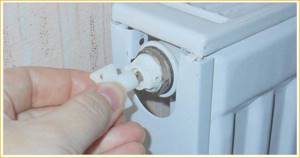
Step 5: Start draining the radiators. Now it's time for the real work. Open the outlet valve to allow water to flow out freely. To make the liquid flow faster, just open the tap a full turn. If the radiator is equipped with a drain hole at the top, then open it, this will increase the water pressure.
The liquid drained from the heating has an unpleasant rusty tint. Often the water turns into a cloudy slurry if the inspection has not been carried out for a long time. Drain the coolant exclusively into the sewer. The best option would be to dispose of it in the toilet, since the water in the centralized heating system contains chemicals that can cause illness if it comes into contact with the skin and mucous membranes.
Sometimes a certain amount of air enters the system, which impedes the movement of water. If this happens, you can organize a return flow of fluid into the radiator and knock out the air plug. It's easy to do. Attach the return end of the hose to a cold water faucet and run a pressurized stream back into the heater. This should help get rid of the airy area.
Step 6. Check for lack of coolant. Make sure all radiator valves in your home are open and double check if necessary. The draining process takes from 20 minutes to an hour, depending on the volume and type of heating.
If the coolant at the outlet had a rusty and cloudy sediment, it would be a good idea to rinse each radiator separately. Do this using water pressure from a cold tap.
Step 7: Refill the system . After completing the installation of heating radiators or carrying out repair work, it is necessary to refill the batteries. It is important to prevent the formation of air-filled areas. Start by closing any valves you previously opened, and also close the drain valve on the radiator. After filling the entire system, fill the heating boiler (if equipped) with liquid. As soon as the pressure rises to operating values, begin pumping the radiators from below. Then repeat pumping from above. This way all the air is expelled and the tightness is checked.
It is possible to check the quality of operation of radiators in a centralized system only with the onset of the heating season. For residential premises with an independent heating method, the check can be performed at any time.
We recommend adding special inhibitors to the water to slow down the corrosion process. But their use is only suitable for closed heating circuits. This method is not applicable for central heating batteries with main supply.
Who should do this?
The management company is responsible for the serviceability of communication networks in apartment buildings. The drainage of the heating riser must be agreed upon with them. And most often, invite their own specialists. Hence the questions and ambiguities:
1. Can I choose my own date?
Almost impossible. The management company itself determines the day and time. You can ask to drain the water from the system within a certain time frame only through great connections.
2. At whose expense is the heating riser drained?
Only at the expense of the tenants. They will ask for money both for the approval procedure and for the participation of specialists. Tariffs in different regions and in different companies vary greatly. It is impossible to predict the amount. In one town they will ask for a thousand, and in another - five. The price includes turning off the system, draining the coolant and then filling the network.
If repairs need to be done at the height of the heating season, you will have to convince the management company of the dire need and pay many times more. If it’s below thirty degrees outside, no one will turn anything off. The only exceptions will be emergency situations.
Is it possible to do without draining the riser?
Minor repairs or simply replacing the battery do not require draining the entire heating system. In almost all apartments, you can shut off a separate radiator without affecting the general circuit.
1. Turn the corresponding tap on the heating riser and shut off the coolant supply.
2. Open the outlet valve on the radiator or unscrew the cap using an adjustable wrench. Drain the water into a container.
If there is neither a plug nor a tap, then disconnect the heating battery and drain the coolant. This will turn out to be more difficult and dirtier, but there is no other way.
Sometimes, for minor repairs, you do not need to drain the water, but simply shut off its supply to the internal circuit.
Draining a heating riser in a private house
The owner of a private house can drain the coolant himself at any convenient time. First he needs to find the taps that shut off the riser.
There are several types of heating systems. There are quite a lot of them, but their operating principles are similar. It is important to get the point:
- find the necessary shut-off valves;
- shut down the network;
- drain the coolant.
Let's look at the example of individual circuits.
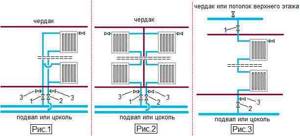
The first picture shows a heating system with bottom supply. In it, the supply and return pipes are located in the basement or ground floor. The coolant is supplied from below, goes through the “idle” riser to the upper floor and returns through the heating devices through another riser. If the house has such a heating system, then two pipes located nearby are visible in the rooms.
How to drain a heating riser
1. Close the valves on the supply riser (1) and return riser (2).
2. Open the drain valves (3) and drain the coolant.
The second picture also shows a system with bottom feed. Only the supply and return risers are located in different rooms. Therefore, taps 1 and 2 can be spaced apart. And the procedure for draining the coolant is the same.
The third picture shows a system with top coolant supply. The supply line is located in the attic or under the ceiling of the upper floor.
Procedure for draining the heating riser:
- close valve 1 in the attic;
- find valve 2 in the basement and turn it off too;
- remove plug 3 and drain the coolant.
The same systems are made in multi-storey buildings.
It often becomes a necessary measure due to an emergency situation in the autonomous heating of the house or the departure of the owners for a long period of time in the winter. The question of how to do this was discussed in another article.
If you have a heating system with natural circulation installed (Fig. 1), you must immediately ensure that the boiler stops operating. Only after this can water be drained from the heating system.
. The discharge is made through a tap (valve), which should be located at the lowest point of the return line, usually next to the boiler. It is advisable to have a hose for this type of work. One end of the hose must be put on the tap, and the other end must be extended to the nearest place with soil, for example, a front garden, a vegetable garden, or, in extreme cases, drained into the sewer. After this, open the tap and wait until the hose stops flowing. It often happens that not everything has flowed out of the system; make sure that after removing the hose you can remove any remaining water.
Using the same method, you can discharge water from a heating system with forced circulation, which includes a pump that is not included in the boiler design. The reset procedure is the same.
Many modern systems are equipped with boilers that include a circulation pump (Fig. 2). The heating system installation method differs from the above, therefore, the supply and return pipes can be located above the baseboard or in the floor structure, just like the “warm floor” system.
1. First, turn off the boiler.
2. Place the hose on the tap from which water is drained from the heating system. It is advisable to put it on the return line (the right pipe coming from the boiler) to make a reset faster. If they are not under the boiler, find where they are. The other end of the hose can be directed into the sewer (a specially made outlet for drainage) or simply into a bucket.
3. Open the tap, wait until the water stops flowing (pressure drops) and turn off the tap.
4. Now we need to organize air access into the system. To do this, open the highest Mayevsky tap, usually installed on the heated towel rail (if equipped). If it is not available, on any radiator (for a two-story house, on the second floor).
5. Repeat the water draining procedure using the hose.
6. Now you can open all the remaining closed Mayevsky taps and repeat draining the water from the heating system again.
7. That's not all, now remove the hose from the return line and put it on the supply valve.
8. And reset again. The lower the hose is located along its entire length relative to the taps, the more water will drain from the heating.
Please note that water cannot be removed from the “warm floor” system in this way; a compressor or other equipment must be used.
Draining water from the heating system is not a quick procedure and requires some attention.



